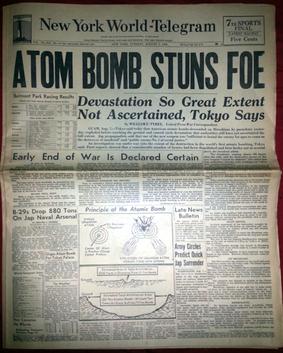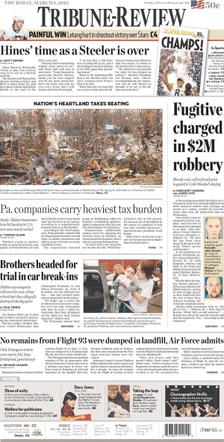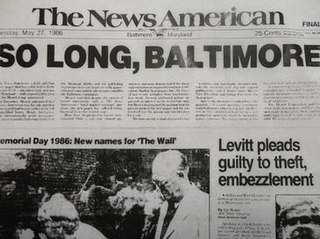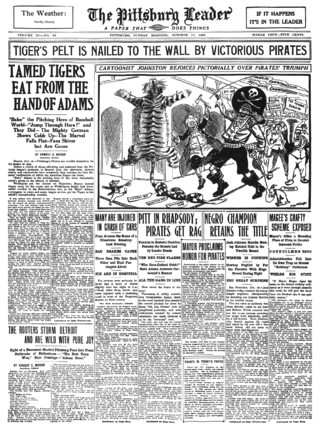
Hearst Communications, Inc., often referred to simply as Hearst, is an American multinational mass media and business information conglomerate based in Hearst Tower in Midtown Manhattan in New York City.

The New York World-Telegram, later known as the New York World-Telegram and The Sun, was a New York City newspaper from 1931 to 1966.

The Pittsburgh Tribune-Review, also known as "the Trib", is the second-largest daily newspaper serving the Greater Pittsburgh metropolitan area of Western Pennsylvania. It transitioned to an all-digital format on December 1, 2016, but remains the second-largest daily in Pennsylvania, with nearly one million unique page views monthly. Founded on August 22, 1811, as the Greensburg Gazette and consolidated with several papers into the Greensburg Tribune-Review in 1889, the paper circulated only in the eastern suburban counties of Westmoreland and parts of Indiana and Fayette until May 1992, when it began serving all of the Greater Pittsburgh metropolitan area after a strike at the two Pittsburgh dailies, the Pittsburgh Post-Gazette and The Pittsburgh Press, deprived the city of a newspaper for several months.
The Syracuse Herald-Journal (1925–2001) was an evening newspaper in Syracuse, New York, United States, with roots going back to 1839 when it was named the Western State Journal. The final issue — volume 124, number 37,500 — was published on September 29, 2001. The newspaper's name came from the merger of the Syracuse Herald and the Syracuse Journal.

The New York Journal-American was a daily newspaper published in New York City from 1937 to 1966. The Journal-American was the product of a merger between two New York newspapers owned by William Randolph Hearst: The New York American, a morning paper, and the New York Evening Journal, an afternoon paper. Both were published by Hearst from 1895 to 1937. The American and Evening Journal merged in 1937.
The Newspaper Preservation Act of 1970 was an Act of the United States Congress, signed by President Richard Nixon, authorizing the formation of joint operating agreements among competing newspaper operations within the same media market area. It exempted newspapers from certain provisions of antitrust laws. Its drafters argued that this would allow the survival of multiple daily newspapers in a given urban market where circulation was declining. This exemption stemmed from the observation that the alternative is usually for at least one of the newspapers, generally the one published in the evening, to cease operations altogether.

The Houston Post was a newspaper that had its headquarters in Houston, Texas, United States. In 1995, the newspaper shut down, and its assets were purchased by the Houston Chronicle.

The Baltimore News-American was a broadsheet newspaper published in downtown Baltimore, Maryland until May 27, 1986. It had a continuous lineage of more than 200 years. For much of the mid-20th century, it had the largest circulation in the city.

The Pittsburgh Post-Gazette, also known simply as the PG, is the largest newspaper serving metropolitan Pittsburgh in the U.S. state of Pennsylvania. Descended from the Pittsburgh Gazette, established in 1786 as the first newspaper published west of the Allegheny Mountains, the paper formed under its present title in 1927 from the consolidation of the Pittsburgh Gazette Times and The Pittsburgh Post.
The Capital, the Sunday edition is called The Sunday Capital, is a daily newspaper published by Capital Gazette Communications in Annapolis, Maryland, to serve the city of Annapolis, much of Anne Arundel County, and neighboring Kent Island in Queen Anne's County. First published as the Evening Capital on May 12, 1884, the newspaper switched to mornings on March 9, 2015.

The News Journal is a daily newspaper in Wilmington, Delaware. It is headquartered in unincorporated New Castle County, Delaware, near New Castle, and is owned by Gannett.

The Pittsburgh Press, formerly The Pittsburg Press and originally The Evening Penny Press, was a major afternoon daily newspaper published in Pittsburgh, Pennsylvania for over a century, from 1884 to 1992. At the height of its popularity, the Press was the second-largest newspaper in Pennsylvania behind The Philadelphia Inquirer. For four years starting in 2011, the brand was revived and applied to an afternoon online edition of the Pittsburgh Post-Gazette.
The Syracuse Telegram was established in 1922 in Syracuse, New York, by William Randolph Hearst. Between the years 1922–1925, the newspaper was published as both Syracuse Telegram and Syracuse Evening Telegram and the Sunday edition was called the Syracuse American, and alternately the Syracuse Sunday American.

The Pittsburgh Leader was a newspaper published from 1864 to 1923 in Pittsburgh, Pennsylvania.
The Pittsburg Times was a morning daily newspaper published in Pittsburgh, Pennsylvania, from 1880 to 1906. It was a predecessor of The Gazette Times, which in turn was succeeded by the present-day Pittsburgh Post-Gazette.

The Pittsburgh Mercury was a weekly newspaper published in Pittsburgh, Pennsylvania from 1811 to the early 1840s. Originally almost unpartisan, it became a mouthpiece of the Democratic-Republicans, and later of the Jacksonians and Democrats. It was a progenitor of the Pittsburgh Post, which in turn was succeeded by the Pittsburgh Post-Gazette.

The American Manufacturer was a newspaper published in Pittsburgh, Pennsylvania, United States, on a mostly weekly basis from 1830 until 1842. The paper supported Jacksonian Democratic politics and was known for its radical and provocative content. Its successor by merger was the Pittsburgh Post, which by further consolidation became the Pittsburgh Post-Gazette.














